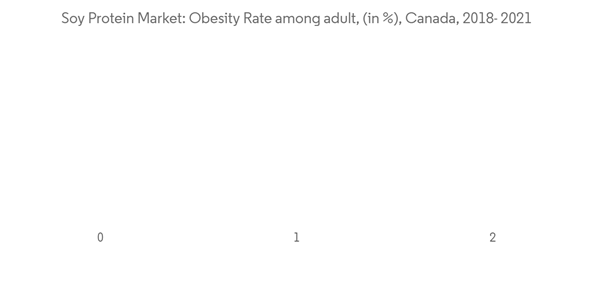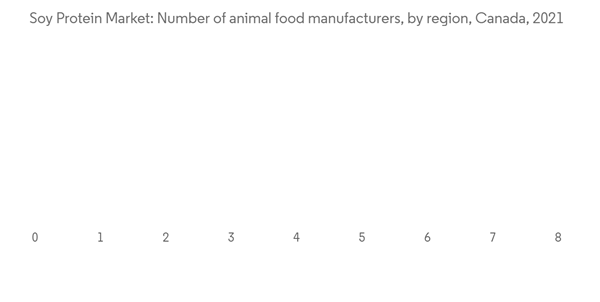Key Highlights
- The soy protein isolate is commonly used in protein bars, shakes, and other supplements. It is a great source of protein for vegetarians and vegans. It is also low in fat and contains no cholesterol, making it a heart-healthy choice.
- Frequent consumption of soy protein can reduce the risk of heart disease, minimize cholesterol levels, and promote healthy bones. A wide variety of product variants are available, including soy protein isolate, soy protein concentrate, and textured soy protein. Soy protein is gaining traction among health-conscious people. Increasing awareness about the health benefits of soy protein is boosting the demand for the product from soy protein in Canada.
- Canada's soy protein market is projected to witness significant growth avenues in the coming years. The growing use of soy protein in numerous applications is pushing the market growth. The expanding vegan and vegetarian population, along with the surging trend of plant-based diets, are fueling the market growth. As per research conducted by the Angus Reid Institute in 2022, 1 in 5 Canadians, 22%, who regularly eat meat would like to reduce the amount of meat they consume and move towards vegetarian.
- Furthermore, the extensive product application in various industries, including food and beverages, animal feed, and supplements industries, owing to its various functional properties, such as emulsification, foaming, and gelling, are fueling the Canadian market growth.
Canada Soy Protein Market Trends
Rise in health consciousness across the country
- The increase in health consciousness acts as one of the major factors driving the growth of the Canadian soy protein market. The rise in demand for plant protein products owing to their functional efficiency and cost competitiveness and utilization in a wide variety of processed foods, especially in the ready-to-eat product category, accelerates the market growth.
- The increased demand for use in food & beverage and animal feed applications and the rise in demand for efficient and cost-effective meat alternatives across supplements further influence the market. Additionally, a surge in food spending, media influence on consumer awareness, adoption of healthy lifestyles, high use in a range of food, and increase in demand for protein-rich diet positively affect the soy protein market.
- As per the Canadian Community Health Survey, there is a continuous increase in the obesity rate in Canada. In 2020, the rate was 28.2%, which was observed to increase in 2021 to 29.2%. Thus, consumers are opting for healthy lifestyles and choosing plant-based protein in the country. Moreover, the market growth of soy protein is attributed to the high nutritional value of soy, the increase in awareness about the benefits of proteins, the rise in demand for a protein-rich diet, and health and wellness trends.
- Along with this, soy is a cheaper source of protein as compared to other sources, and hence, it drives the market for soy protein. Also, soy protein is the preferred alternative to meat and dairy proteins, which further fuels the market growth.
Animal Feed is the largest End User
- Soy protein, largely in the form of concentrates, is widely used in the diets of animals, birds, and fish. Its main characteristics, such as easy digestibility, improved shelf life, and protein enrichment, are driving its application in the food and beverage segment. Moreover, agriculture and aquaculture produce are identified as one of the leading markets for soy protein, as the use of soy protein in animal feed marginally surpasses its usage in food and beverages.
- Agriculture and aquaculture industries are investing a huge amount in soy proteins. The yield of aquaculture produce is maximized, and livestock farmers also appreciate the health benefits that are offered by the addition of soy protein in animal feed.
- Moreover, animal feed is another application sector that has been witnessing growth and is aiding the soy protein market. With companies undertaking multiple research and development undertakings, the market is being further propelled forward.
- For instance, Nordic Soya, a Finnish business, creates soy protein-based aqua as well as animal feed. Soy protein isolate is used in the formulation of these feed products. The rising innovation by the key manufacturers in the animal feed market is also providing an impetus for its growth. The diversification of products comprised of plant-based proteins like soy proteins is expected to drive the Canadian soy protein market in the coming years.
Canada Soy Protein Industry Overview
The Canadian soy protein market is moderately consolidated, with the top five companies occupying 64.74%. The major players in this market are Archer Daniels Midland Company, CHS Inc., DuPont de Nemours Inc., Kerry Group PLC, and The Scoular Company (sorted alphabetically).For instance, in 2021, ADM, a global leader in nutrition and agricultural origination and processing, acquired Sojaprotein, a leading provider of non-GMO soy ingredients. The addition represents a significant expansion of ADM's alternative protein capabilities and its ability to meet the growing demand for plant-based foods and beverages.
Additional Benefits:
- The market estimate (ME) sheet in Excel format
- 3 months of analyst support
This product will be delivered within 2 business days.










